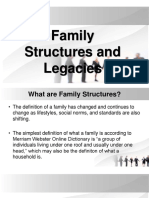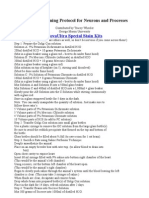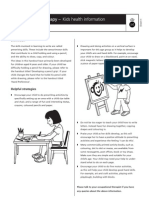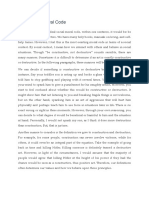0 ratings0% found this document useful (0 votes)
16 viewsFamily
Family
Uploaded by
Fahim ahmedThe document discusses the definition and types of families. It defines a family as consisting of a householder and one or more related individuals living in the same household through birth, marriage, or adoption. Families can be nuclear, consisting of parents and children, extended, including additional relatives, or joint, encompassing multiple generations living together. The functions of family are also examined from the perspectives of functionalism, conflict theory, and symbolic interactionism.
Copyright:
© All Rights Reserved
Available Formats
Download as PPTX, PDF, TXT or read online from Scribd
Family
Family
Uploaded by
Fahim ahmed0 ratings0% found this document useful (0 votes)
16 views7 pagesThe document discusses the definition and types of families. It defines a family as consisting of a householder and one or more related individuals living in the same household through birth, marriage, or adoption. Families can be nuclear, consisting of parents and children, extended, including additional relatives, or joint, encompassing multiple generations living together. The functions of family are also examined from the perspectives of functionalism, conflict theory, and symbolic interactionism.
Original Title
family
Copyright
© © All Rights Reserved
Available Formats
PPTX, PDF, TXT or read online from Scribd
Share this document
Did you find this document useful?
Is this content inappropriate?
The document discusses the definition and types of families. It defines a family as consisting of a householder and one or more related individuals living in the same household through birth, marriage, or adoption. Families can be nuclear, consisting of parents and children, extended, including additional relatives, or joint, encompassing multiple generations living together. The functions of family are also examined from the perspectives of functionalism, conflict theory, and symbolic interactionism.
Copyright:
© All Rights Reserved
Available Formats
Download as PPTX, PDF, TXT or read online from Scribd
Download as pptx, pdf, or txt
0 ratings0% found this document useful (0 votes)
16 views7 pagesFamily
Family
Uploaded by
Fahim ahmedThe document discusses the definition and types of families. It defines a family as consisting of a householder and one or more related individuals living in the same household through birth, marriage, or adoption. Families can be nuclear, consisting of parents and children, extended, including additional relatives, or joint, encompassing multiple generations living together. The functions of family are also examined from the perspectives of functionalism, conflict theory, and symbolic interactionism.
Copyright:
© All Rights Reserved
Available Formats
Download as PPTX, PDF, TXT or read online from Scribd
Download as pptx, pdf, or txt
You are on page 1of 7
What is Family?
• Family is a basic unit of Social Structure.
• Family, as defined by the U.S. Census Bureau
“A family includes a householder and one or
more people living in the same household who
are related to the householder by birth,
marriage, or adoption.”
….(continued) What is Family?
• In the most basic definition, a group of people who share a legal bond or
a blood bond is a family.
• Legal Bonds: Families are legally bound through marriages, adoptions,
and guardianships, including the rights, duties, and obligations of those
legal contracts. Legal bonds can be changed, expanded, or dissolved to
change the composition of a family.
• Blood Bonds: Individuals who are directly related through a common
ancestor are part of a family. This includes both close and distant
relatives such as siblings, parents, grandparents, aunts, uncles, nieces,
nephews, and cousins. Researching a family tree or genealogical records
can reveal familial blood bonds.
• Despite the apparent simplicity of this definition of family, the idea of
family goes far beyond just legal or blood relationships for many people.
Types of Family in Bangladesh
• Nuclear Family
In modern times, a nuclear family is simply defined to be a
social unit with a mother, father, and children
• Extended Family
This is simply the extension of an nuclear family. This family
consists of grandparents, parents, children, uncle, aunties.
• Joint Family
This is a type of extended family consisting of grandparents,
parents, children, uncle, aunties, wife/husands of
uncles/aunties, cousins.
Functions of Family according to
Functionalists
• It socializes children, it provides emotional
and practical support for its members,
• it helps regulate biological relationship and
reproductive activity,
• it provides its members with a social identity.
• In addition, sudden or far-reaching changes in
the family’s structure or processes threaten its
stability and weaken society.
Functions of Family according to Conflict
Perspectives
• The family contributes to social inequality by
reinforcing economic inequality and by
reinforcing patriarchy.
• The family can also be a source of conflict,
including physical violence and emotional
cruelty, for its own members.
Functions of Family according to Symbolic
Interactionists
• The interaction of family members and
intimate couples involves shared
understandings of their situations.
• Wives and husbands have different styles of
communication, and social class affects the
expectations that spouses have of their
marriages and of each other.
You might also like
- Kenworth Wiring Diagrams t4, t6 & t9 Conventional ModelsDocument78 pagesKenworth Wiring Diagrams t4, t6 & t9 Conventional ModelsDavid Fuentes91% (43)
- Statement of The ProblemDocument9 pagesStatement of The ProblemNieL ReSpiCiO86% (7)
- Music Marketing: When Culture Meet The BusinessDocument2 pagesMusic Marketing: When Culture Meet The BusinessartucustomNo ratings yet
- Presentation On Family, Kinship and MarriageDocument36 pagesPresentation On Family, Kinship and Marriageyumechan139No ratings yet
- FamilyDocument26 pagesFamilyBahauddin HasanNo ratings yet
- KinshipDocument45 pagesKinshipRuby Lorenz DaypuyartNo ratings yet
- Part I Prelimenary - TDocument26 pagesPart I Prelimenary - TSindhu BhattaraiNo ratings yet
- Rev 4 - ExamDocument5 pagesRev 4 - ExamLouem GarceniegoNo ratings yet
- Family Institution Assignment 1Document30 pagesFamily Institution Assignment 1Muhammad Ali Khan100% (1)
- Wanna One ProfileDocument31 pagesWanna One ProfileChristine SeoNo ratings yet
- Cultural, Social and Political InstitutionsDocument27 pagesCultural, Social and Political InstitutionsMichelle Berme85% (13)
- PerdevDocument25 pagesPerdevRob FyockNo ratings yet
- Updated - Final - Week 2 - LectureDocument90 pagesUpdated - Final - Week 2 - Lectureسُندس الحاجيNo ratings yet
- Nota Ringkas AA20303 Sistem KekeluargaanDocument33 pagesNota Ringkas AA20303 Sistem KekeluargaanDessyEchi67% (6)
- Family and EducationDocument19 pagesFamily and Educationsomintacshane792No ratings yet
- Module 6 KinshipDocument39 pagesModule 6 Kinshipjhenerbong.nonesaNo ratings yet
- Levels of ClienteleDocument60 pagesLevels of ClienteleBroskiNo ratings yet
- Kinship, Marriage and The HouseholdDocument28 pagesKinship, Marriage and The Householdlea gutierrezNo ratings yet
- KINSHIPDocument14 pagesKINSHIPOtencianoNo ratings yet
- Dos - HSMC101-18Document337 pagesDos - HSMC101-18uditanshu2605No ratings yet
- The FamilyDocument39 pagesThe FamilyAlexious Marie Callueng100% (2)
- KinshipDocument34 pagesKinshipRowjan SantosNo ratings yet
- The Family Today 1Document25 pagesThe Family Today 1Chenie ClerigoNo ratings yet
- UCSPDocument19 pagesUCSPVirgilNo ratings yet
- Unit II Social Institutions and Groups SocializationDocument38 pagesUnit II Social Institutions and Groups SocializationShafiq Ur RahmanNo ratings yet
- Kinshipmarriageandthehousehold 170907030015Document35 pagesKinshipmarriageandthehousehold 170907030015Ronalyn CajudoNo ratings yet
- Cultural Health Society Unit 2Document53 pagesCultural Health Society Unit 2teemergill777No ratings yet
- Indian Traditional Family IdeologyDocument19 pagesIndian Traditional Family IdeologyPrinsu Sen100% (1)
- Families Kinship and DescentDocument42 pagesFamilies Kinship and DescentAnn Marie Palahang100% (1)
- CB FamilyDocument8 pagesCB FamilyRebeka HossainNo ratings yet
- Unit II Social Institutions and Groups SocializationDocument39 pagesUnit II Social Institutions and Groups Socialization8521sulimanNo ratings yet
- Prepared By:: Crizalde R. Puerto Bsed Het-4Document17 pagesPrepared By:: Crizalde R. Puerto Bsed Het-4Zal ZalNo ratings yet
- Unit 2Document52 pagesUnit 2Muhammad GulNo ratings yet
- Kinshipmarriageandthehousehold 170907030015Document35 pagesKinshipmarriageandthehousehold 170907030015Monria FernandoNo ratings yet
- The Family PDFDocument40 pagesThe Family PDFsfdNo ratings yet
- The-Family As An InstitutionDocument24 pagesThe-Family As An InstitutionreyshelleannecarillotangcoraNo ratings yet
- Kinship by Blood and MarriageDocument12 pagesKinship by Blood and MarriageHannah Aquino75% (4)
- UCSP Report 2 Group 5 Finalized 085831Document102 pagesUCSP Report 2 Group 5 Finalized 085831Mushrooms SteakNo ratings yet
- Week 6. Cultural, Social, and Political Institutions (Part 1)Document9 pagesWeek 6. Cultural, Social, and Political Institutions (Part 1)Reynaldo Campos ParisNo ratings yet
- Introduction To FamilyDocument4 pagesIntroduction To FamilyRiya LalNo ratings yet
- Perdev Module11Document31 pagesPerdev Module11jerseydenessNo ratings yet
- The Family A. Family As Basic Unit of The SocietyDocument84 pagesThe Family A. Family As Basic Unit of The SocietyWilma Beralde100% (1)
- 16 Ucsp Kinship, Marriage and The HouseholdDocument35 pages16 Ucsp Kinship, Marriage and The HouseholdTheDefender DotcomNo ratings yet
- Q2 - 06 - Kinship, Marriage and HouseholdDocument37 pagesQ2 - 06 - Kinship, Marriage and HouseholdHenry BuemioNo ratings yet
- Kinship, Marriage, and The HouseholdDocument31 pagesKinship, Marriage, and The HouseholdJestoni AmbrocioNo ratings yet
- The Concept of The Family 2020Document55 pagesThe Concept of The Family 2020Maria HudsonNo ratings yet
- Lesson 1 Marriage and Family RelationshipsDocument66 pagesLesson 1 Marriage and Family RelationshipsDaisy BansilNo ratings yet
- How SocietyDocument16 pagesHow SocietyNicoleAdrienneRiveraNo ratings yet
- Lesson 5 - Kinship, Marriage, and The HouseholdsDocument23 pagesLesson 5 - Kinship, Marriage, and The Householdsmescobin.fsgincNo ratings yet
- Ucsp ReviewerDocument12 pagesUcsp ReviewerMaria CaroNo ratings yet
- Some Examples of Family Patterns AreDocument5 pagesSome Examples of Family Patterns AreAngel BocadoNo ratings yet
- Family & Marriage: Course Code: SOC101 Course Teacher: Farhana Sultana (FNS)Document49 pagesFamily & Marriage: Course Code: SOC101 Course Teacher: Farhana Sultana (FNS)Renjumul MofidNo ratings yet
- Kinship Marriage and HouseholdDocument26 pagesKinship Marriage and Householdgandaku2No ratings yet
- Family MBBS2022Document10 pagesFamily MBBS2022ALok AcharyaNo ratings yet
- Family and HouseholdDocument13 pagesFamily and HouseholdAlvin A. GangeNo ratings yet
- Madhu Socio PDFDocument35 pagesMadhu Socio PDFmaddy bhujelNo ratings yet
- Gender and FamilyDocument20 pagesGender and FamilyFLORVIN BAYABORDANo ratings yet
- Extensive Detailed On Entire SyllabusDocument21 pagesExtensive Detailed On Entire SyllabusboushrakhadNo ratings yet
- Family Structure AND LegaciesDocument59 pagesFamily Structure AND Legaciesmaximacamero61No ratings yet
- Gender and FamilyDocument27 pagesGender and FamilyMia kathleen RomaNo ratings yet
- Second Topics - Docx CLASSIFICATION OF THE FAMILYDocument7 pagesSecond Topics - Docx CLASSIFICATION OF THE FAMILYpanesimee4No ratings yet
- Impact of Online Advertising On Consumers Buying Behaviour: A Study With Reference To Karkala TalukDocument5 pagesImpact of Online Advertising On Consumers Buying Behaviour: A Study With Reference To Karkala TalukbobNo ratings yet
- Inert Gas SystemDocument9 pagesInert Gas Systemdj22500100% (3)
- PSSU DATASHEET - Hw-PSSU-v9Document4 pagesPSSU DATASHEET - Hw-PSSU-v9workdata2223No ratings yet
- Principles of Interior Design-20 Jan-11Document9 pagesPrinciples of Interior Design-20 Jan-11Sandip Ghadge100% (1)
- Entanglements, or Transmedial Thinking About Capture by Rey ChowDocument20 pagesEntanglements, or Transmedial Thinking About Capture by Rey ChowDuke University PressNo ratings yet
- Study Guide Template EDITEDDocument5 pagesStudy Guide Template EDITEDRico EsponillaNo ratings yet
- Moot Cases ListDocument3 pagesMoot Cases ListadityatnnlsNo ratings yet
- Tesco Plans To Open Las Vegas SupermarketsDocument2 pagesTesco Plans To Open Las Vegas SupermarketsHuong NguyenNo ratings yet
- Exxon Mobil New Refinery TrendsDocument45 pagesExxon Mobil New Refinery TrendsWong Yee Sun100% (1)
- Golgi-Cox Staining Protocol For Neurons and Processes: Novaultra Special Stain KitsDocument3 pagesGolgi-Cox Staining Protocol For Neurons and Processes: Novaultra Special Stain KitstetrazolamNo ratings yet
- Crossword Puzzle Print Out For Kids Biology - The Human BodyDocument2 pagesCrossword Puzzle Print Out For Kids Biology - The Human BodychristalNo ratings yet
- Dux Scaler Spec Sheet - Fix Cab PDFDocument2 pagesDux Scaler Spec Sheet - Fix Cab PDFvivalpsNo ratings yet
- Pre Writing Info SheetDocument6 pagesPre Writing Info SheetkellykidmanNo ratings yet
- SumerDocument16 pagesSumerJuneyell Escobar100% (1)
- Module 1 Introduction To Applied EconomicsDocument6 pagesModule 1 Introduction To Applied EconomicsLa salette roxasNo ratings yet
- Trough Chain Conveyor RFKG Flyer enDocument2 pagesTrough Chain Conveyor RFKG Flyer enCharlesNo ratings yet
- A Control Engineers Quide To Sliding Mode ControlDocument14 pagesA Control Engineers Quide To Sliding Mode ControlyalllikNo ratings yet
- String TheoryDocument5 pagesString TheoryDarshan M MNo ratings yet
- Introduction To Nucleic AcidsDocument11 pagesIntroduction To Nucleic AcidsAsif AliNo ratings yet
- Writing SkillsDocument30 pagesWriting SkillsMizter'Lar IntavanhNo ratings yet
- Attached To Decision No. 652 /QD-ĐHNN, Dated April 9, 2015 of The President of ULIS-VnuDocument2 pagesAttached To Decision No. 652 /QD-ĐHNN, Dated April 9, 2015 of The President of ULIS-VnuThảo HươngNo ratings yet
- Backflush CostingDocument45 pagesBackflush CostingKIROJOHNo ratings yet
- Wstęp Do Językoznawstwa - NotatkiDocument14 pagesWstęp Do Językoznawstwa - NotatkijoannaaaaNo ratings yet
- New Composite 2024Document38 pagesNew Composite 2024pushpender bajajNo ratings yet
- ACI 533 5R 20 Guide For Precast Concrete Tunnel Segments 2020Document84 pagesACI 533 5R 20 Guide For Precast Concrete Tunnel Segments 2020haddad.marianne.23No ratings yet
- Permitting Procedures HazardousDocument35 pagesPermitting Procedures HazardousCarol YD60% (10)
- PNP Silicon AF Transistors BC 327 BC 328: Type Marking Package Pin Configuration 1 2 3 Ordering CodeDocument6 pagesPNP Silicon AF Transistors BC 327 BC 328: Type Marking Package Pin Configuration 1 2 3 Ordering CodeSince the EndNo ratings yet

























































































